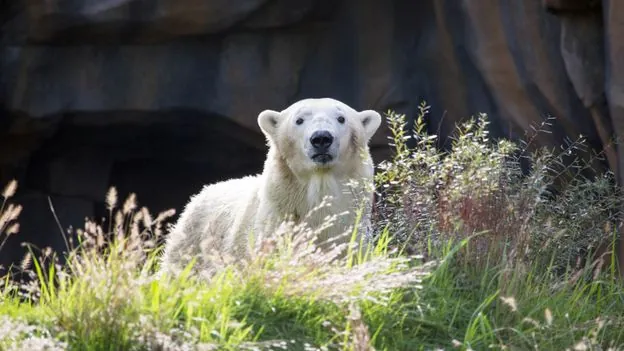
Siku the Polar Bear: The Unexpected Rise of Allergies in Zoo Animals
2025-04-03
Author: Ling
Unexpected Rise of Allergies in Zoo Animals
A report released recently sheds light on a peculiar phenomenon observed at the Lincoln Park Zoo in Chicago: a polar bear named Siku developing allergies, suggesting that captivity conditions may trigger similar reactions in various animal species.
Siku's Allergy Discovery
Back in 2018, caretakers at the zoo noticed Siku shedding hair, revealing patches of black skin. His persistent scratching and irritation led Kathryn Gamble, the zoo's director of veterinary medicine, to suspect allergies. To find out more, Siku was anesthetized for skin testing, revealing surprising triggers: common allergens like house mites and pollen from elm, mulberry, and red cedar trees, with an exceptionally strong reaction to human hair dander.
Allergies in the Animal Kingdom
While humans are often thought of as the primary victims of allergies, it turns out that a plethora of animals—from pets like dogs and cats to exotic species such as rhinoceroses and dolphins—can also suffer from allergic reactions. This trend has been noted in various species at Lincoln Park Zoo, including black leopards, fennec foxes, and black bears. In fact, allergies in animals may reflect a larger trend affecting pets as well, where rates are reportedly climbing.
Causes of Allergies in Zoo Animals
But what's causing this unexpected allergic response among animals? Experts like Annette Petersen from Michigan State University indicate that the rise in allergies corresponds with similar increases in allergies among humans, particularly in urban settings. They suggest that animals exposed to highly sanitized environments are less likely to encounter the diverse pathogens and microbes they evolved alongside, leading their immune systems to misfire.
Manifestation of Allergy Symptoms
The consequences of allergies can manifest differently across species. For instance, while humans and primates may suffer from respiratory issues, many animals develop skin conditions as their primary symptoms. For example, allergic dogs may frequently lick their paws and scratch sensitive areas, while horses can develop hives.
The Role of Cleanliness and Antibiotics
The modern focus on cleanliness and the use of antibiotics might also be creating a problem. The theory is that while these practices aim to protect health, they might actually hinder the immune system's ability to differentiate between benign substances and genuine threats, causing it to overreact to allergens. Early childhood exposure to a variety of microbes is believed to be crucial in correctly training the immune system.
Insights from Amish Populations
Interestingly, studies on Amish populations reveal that children regularly exposed to traditional farming practices—where they interact with animals and naturally occurring dust—experience significantly lower allergy rates compared to those in industrial farming settings. This has led researchers to speculate that similar principles could apply to zoo animals like Siku.
Impact of Climate Change
Among other factors, climate change drives higher pollen counts and longer allergy seasons, compounding the problem.
Treatment Innovations
Nevertheless, there's good news: allergy treatments for animals are on the rise. Treatments for animals have started to mirror those used in humans—like allergy shots—where small doses of allergens help desensitize their immune systems. For instance, Siku was treated with a mix of allergens in organic honey to make it easier for him to absorb the substances, resulting in a significant reduction in his allergic reactions over a three-year period.
Broader Implications
This astonishing development has implications beyond Siku. Researchers now seek ways to expose zoo animals and farm animals to beneficial microorganisms safely, potentially reducing allergies and improving their overall health. It is a vivid reminder that the fight against allergies involves not just human health but animal welfare too.
The Future of Allergy Treatment in Animals
As our understanding of allergies evolves, it underlines the importance of a rich microbiome in nurturing healthy immune responses—both in humans and the animals we cherish. Will we soon see farms and zoos adopting probiotic strategies for animals? Only time will tell, but one thing is clear: Siku’s story is drawing attention to the intricate balance of health in both humans and animals, prompting a deeper investigation into the causes of allergies across species.





 Brasil (PT)
Brasil (PT)
 Canada (EN)
Canada (EN)
 Chile (ES)
Chile (ES)
 Česko (CS)
Česko (CS)
 대한민국 (KO)
대한민국 (KO)
 España (ES)
España (ES)
 France (FR)
France (FR)
 Hong Kong (EN)
Hong Kong (EN)
 Italia (IT)
Italia (IT)
 日本 (JA)
日本 (JA)
 Magyarország (HU)
Magyarország (HU)
 Norge (NO)
Norge (NO)
 Polska (PL)
Polska (PL)
 Schweiz (DE)
Schweiz (DE)
 Singapore (EN)
Singapore (EN)
 Sverige (SV)
Sverige (SV)
 Suomi (FI)
Suomi (FI)
 Türkiye (TR)
Türkiye (TR)
 الإمارات العربية المتحدة (AR)
الإمارات العربية المتحدة (AR)